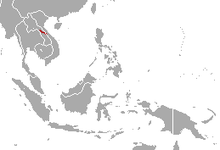

| Long-earned gymnure | |
|---|---|
| Scientific classification | |
| Domain: | Eukaryota |
| Kingdom: | Animalia |
| Phylum: | Chordata |
| Class: | Mammalia |
| Order: | Eulipotyphla |
| Family: | Erinaceidae |
| Subfamily: | Galericinae |
| Genus: | Otohylomys Bannikova, Lebedev, Abramov, Rozhnov, 2014 |
| Species: |
O. megalotis
|
| Binomial name | |
| Otohylomys megalotis Jenkins & M. F. Robinson, 2002 | |

| |
| Long-eared gymnure range | |
The long-eared gymnure (Otohylomys megalotis) is a eulipotyphlan that is found in Laos. This specific type of gymnure has long ears and a long skull compared to that of others.[2] It is also recognized for its broad forefeet, stout claws, and naked hindfeet.[1] While it was previously lumped in with the dwarf and short-tailed gymnures of the genus Hylomys, it is now placed in its own genus Otohylomys.[3]
The term Otohylomys is derived from "otos" (ear), "hylo" (wood) and "mys" (mouse).[3] The term megalotis is derived from the two Greek words "megas" and "otos," which means "large" and "ears", respectively.[4]
Otohylomys megalotis is from the family Erinaceidae. Some special physical features of Erinaceidae are that they have rounded bodies, pointed noses, and short tails.[5] The members of Erinaceidae are considered to be omnivores,[6] and some of their foods are insects, frogs, mice, fruits, and roots.[5]
There are two subfamilies of Erinaceidae: Erinaceinae (hedgehogs) and Galericinae (gymnures).[4] Hedgehogs are nocturnals and have sharp, spiny fur on their backs.[5] Furthermore, hedgehogs are usually found in Africa, Europe, and Asia.[4] On the other hand, gymnures are diurnals and do not have spines.[5] Instead, gymnures usually have stiff, bristly furs, and they produce a pungent smell when they feel threatened.[5] Unlike hedgehogs, gymnures are usually found in South-East Asia and other tropical countries.[4]
The pregnancy lasts around six to seven weeks. They are born blind and hairless. However, the hedgehogs can start growing spiny hairs within 36-hours after birth. Only the mothers raise their young ones.[6]
Otohylomys megalotis is a type of gymnure. Compared to other Hylomys species, O. megalotis has rounder, more prominent, and larger ears. Its soles and tarsals are naked, and it has long and moderately stout claws. The skull of O. megalotis is elongated, flattened, and moderately slender.[4]
Compared to the sizes of Hylomys, O. megalotis is medium in size. However, it has a longer tail. Its tail is about 75% of its head and body length. Instead of having flattened spinous hairs, it has grey, long, soft and fine furs. Unlike Hylomys species, O. megalotis has stronger and tougher teeth.[4]
Otohylomys megalotis is primarily found in Khammouan Province, Laos, specifically in Khammouan Limestone National Biodiversity Conservation Area in Thakheck district.[1] It can also be found in the surroundings of Ban Muang and Ban Doy.[1] It is typically found in areas where there are massive limestone karst that is covered in large boulders, with heavily degraded mixture of deciduous forest, scrub, and bamboos.[4]
Currently, there is no known threat to this species.[1]
|
Extant Erinaceidae species by subfamily
| |||||||||||||
|---|---|---|---|---|---|---|---|---|---|---|---|---|---|
| |||||||||||||
| Erinaceinae (Hedgehogs) |
| ||||||||||||
| Galericinae (Gymnures) |
| ||||||||||||
| Hylomys megalotis |
|
|---|---|